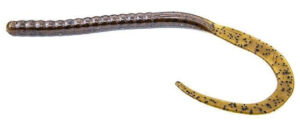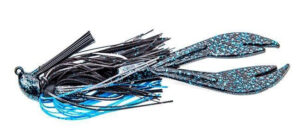6-inch Yum F2 Dinger
I sneak stick worms into just about every pond fishing article I write because they work in almost every situation imaginable. The summer months, however, are when I do the most damage with them.
Whether I’m fishing from a small johnboat or from the bank, I’m going to make a few casts with a stick worm before I try anything else. Pond fish spend a lot of time in shallow water and I believe there are two primary reasons for this behaviorâmost small ponds are, indeed, much shallower than larger bodies of water and many lack suitable deep structure and cover on which bass can position.
Shallow bass are known for being spooky. Even the slightest vibration from walking the banks can cause them to relocate, so the subtle water entry and delicate action of a stick worm can fool these tough-to-catch fish.
RiggingâI like to wacky rig my stick worms when pond fishing by hooking them through the center, creating a parabolic-looking bend in the worm. It’s not as weedless, but it draws strikes when a weightless Texas rig fails.What to targetâCast your stick worm to small, isolated pieces of cover such as stumps and stick-ups. If the cover is too heavy, you may experience some annoying hang-ups due to the exposed hook point. You can also target break lines by casting parallel to the shore.TechniqueâStick worms have a lot of natural action in the water, so don’t overcomplicate it. Make a long cast, let it sink on a slack line and when it hits the bottom, lightly twitch your rod tip before letting it fall on a slack line again. When you get a bite, you’ll often see your line get tight as it swims to the side.
Big worm

Zoom Ol’ Monster
Although many of us tend to overlook the effectiveness of big worms, they’re an incredible tool when you’re dissecting small ponds. When the snakes come out to play in the warmer months, you should always have a pack of ’em in your pocket.
Without a doubt in my mind, pond bass eat snakes. Growing up in Georgia, I saw it all the timeâa foot-long snake swimming lazily across the water, rudely interrupted by a behemoth bass looking for an easy meal. I think that’s what makes big worms so effective in these situations. They look like an unsuspecting snake.
RiggingâThere are two options and both can be equally effective. If you’re more comfortable keeping bottom contact, Texas rig your big worm with a 3/16-ounce bullet weight and a 6/0 round bend offset hook. You can also rig them weightless Texas when you’re around thick vegetation or that infamous “pond scum”.What to targetâIf you’re using a Texas rigged big worm, target the heaviest cover you can find whether it’s blowdowns, grass lines or stump fields. When you use it weightless, try fishing it around large, shallow flats.TechniqueâTwo techniques really shine in this situation. If you’re using a weight, simply drag the worm slowly along the bottom and when you feel it hit a piece of cover, stop your retrieve and shake it in place. I’ve also caught countless big bass by slowly reeling big wormsâthis is a great imitation of a small snake.
Jig with craw trailer
Strike King Hack Attack Jig
It’s no secret that jigs catch big bass, but be mindful of your pond’s bottom composition before committing to a jig. If your pond has a soft bottom filled with rotten leaves, pine straw and other “muck”, a jig may not be the best option because the skirt and weed guard can become tangled in the trash. This will kill the action of your jig and you’ll soon be reeling in clumps of stinky brown stuff.
In ponds with a harder bottom composition, however, such as sand, a jig and craw trailer combination can be incredibly tough to beat. You may not get as many bites as you would on smaller profile baits, but you can expect a big bite throughout the course of the day.
RiggingâI like to thread on a fairly large crawfish-style trailer for increase water displacement and a larger profile. A 3/8-ounce jig is a great starting point and be sure to use 20-pound fluorocarbon line and a heavy-action rod so you can wrestle the big ones in with ease.What to targetâTo be honest, there’s not necessarily a “wrong” place to fish a jig in a pond. Your usual suspects should be shallow cover, of course, but also keep an eye out for small feeder creeks. Crawfish inhabit these shallow creeks and the bass definitely know it.TechniqueâI tend to “hop” a jig more when I’m fishing ponds. Let’s be honest hereâmost ponds are going to have some kind of muck on the bottom, and hopping your jigs serves two purposes. It attracts fish in dirty, shallow water and it also cleans the “salad”, as I call it, off of the skirt, trailer and weed guard.
Topwater frog

SPRO Bronzeye Poppin’ Frog
I may be stating the obvious to some right now, but come onâI couldn’t leave a topwater frog out of this list. There will be times when this technique works throughout the entire day, but you’ll do most of your damage early in the morning, after rainstorms and right before dark. These periods are when frogs tend to be most active and again, the bass know what’s up.
RiggingâI want everyone to promise me you will never use anything but heavy braided line for this technique. Monofilament has far too much stretch to facilitate suitable hook penetration and fluorocarbon sinks, which turns your frog into a submarine. Grab a spool of 65-pound braided line and a heavy-action rod to avoid any heart breaks. It sounds excessive, but you’ll catch a lot more fish this way.What to targetâTargeting shallow cover is almost always effective when pond fishing, but don’t overlook shallow, bare banks. Bass tend to roam in search of feeding opportunities in lowlight conditions, so don’t be afraid to parallel any shallow bank you can find. When you get your first bite, you’ll be hooked.TechniqueâMake a long cast with your topwater frog and twitch your rod tip downward to make your frog “walk the dog” across the water’s surface. Give your line a little slack after each twitch to give the frog its full range-of-motion. If you don’t get bit with this technique, try popping it just like you would a topwater popper.
Floating worm

NetBait T-Mac
If you want to split hairs, floating worms don’t actually floatâthey sink very, very slowly. Lucky for pond anglers, however, this deliberate action is what makes the floating worm so darn effective. If you can’t get bit with bottom-contact presentations, always try one of these dudes before you assume the fish aren’t biting. They can turn a slow day into an unforgettable one in a New York minute.
RiggingâWeightless Texas rigged floating worms are outstanding when fishing in small ponds. If you’d like the worm to stay closer to the surface, try using 10-pound monofilament. Conversely, if you want it to sink a little faster throughout the retrieve, throw it on 10-pound fluorocarbon line. Don’t be turned off when you see these worms in some really “loud” colors such as pink, white and methiolate. The fish still bite ’em out of pure reaction and you’ll also be able to see your worm clearly and easily detect bites close to the surface.What to targetâThe floating worm is a beautiful thing because you can fish them slowly around isolated cover and also fish them very quickly while dissecting flats or paralleling bare banks. As long as the water is relatively shallow, you’ll have a great chance of getting some quality bites.TechniqueâDue to this worm’s versatility, you’re able to do two things with it. You can make a long cast, let it sink a few feet and slowly twitch it when the bass are inactive and you can also utilize a “twitch, twitch, pause” retrieve that drives active bass absolutely nuts. Either way, when you see your worm disappear, don’t wait until you feel the fish. Reel in your slack, set the hook and hold on.
Wakebait
SPRO Baby Fat John 50
If you use the wrong type of crankbait when pond fishing, you might get a sour taste in your mouthâespecially if you’re fishing from the bank. In most cases, the water right in front of the bank is going to be much shallower than the water closer to the middle of the pond. If you’re using a crankbait that runs too deep, it will operate flawlessly until nears the bank. As the water becomes shallower, the crankbait will start to “dig” into the bottom and will ultimately snag submerged trash and lose its action. Not only is it frustrating, but the bass won’t touch it with a ten-foot pole.
As a result, you’ll have more success with shallow running crankbaits or wake baits. Try to stick with models that run no deeper than twoâmaybe threeâfeet deep so you can fish without hassle. These lures usually have a pronounced “wobble” and can attract bass from several feet away.
RiggingâDepending upon your preference, you can get away with using monofilament or fluorocarbon when fishing these shallow crankbaits. I suggest using no lighter than 12-pound test with a medium-action rod.What to targetâYou’ll have a lot of success targeting break lines, or depth changes, with these lures. I like to parallel the bank and focus my efforts on nearby drop-offs and any vegetation lines as well. Bass will hide near both drop-offs and grass lines to ambush innocent passersby.TechniqueâThis is something you don’t really need to overcomplicate. Make a long cast and start reelingâthat’s about as difficult as it gets. Do try, however, to change your retrieve speeds periodically. You may try burning it for a few casts followed by a stop-and-go retrieve on subsequent casts. Just pay attention to what you’re doing when you get a bite so you can duplicate it throughout your fishing trip.
Now this list doesn’t necessarily encompass every effective bait for summer pond fishing, but it does give you a starting point and the ability to make a quick “pond kit” for impromptu after-work or after-school trips to your favorite fishing hole. These are my absolute favorites and they have caught countless bass for me over the years. If you try ’em out, I think you’ll enjoy even more pond fishing fun this summer.










